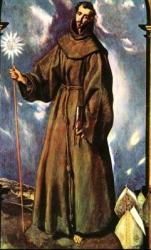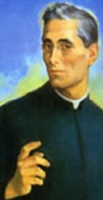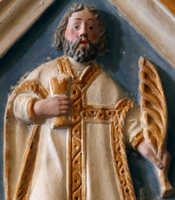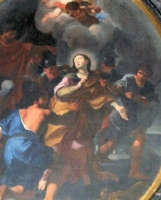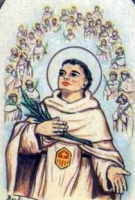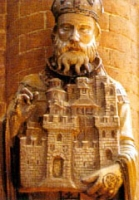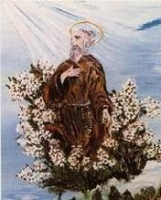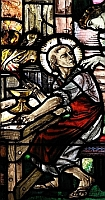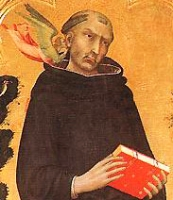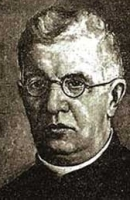St. Maria Bernarda Butler
Feastday: May 19
Patron: Franciscan Missionary Sisters of Our Lady of Perpetual Help
Birth: May 28, 1848
Death: May 19, 1924
Beatified: October 29, 1995, Saint Peter's Basilica, Vatican City by Pope John Paul II
Canonized: October 12, 2008, Saint Peter's Square, Vatican City by Pope Benedict XVI
St. Maria Bernarda Bütler (1848-1924), born Verena Bütler, was a Swiss saint. She founded the Congregation of the Franciscan Missionary Sisters of Mary, Help of Christians and was a missionary in Ecuador. Eventually, her congregation had houses in Colombia, Austria, and Brazil.
María Bernarda Bütler (28 May 1848 – 19 May 1924), born Verena Bütler, was a Swiss Roman Catholic professed religious and the foundress of the Franciscan Missionary Sisters of Mary Help of Sinners, and served in the missions in Ecuador and Colombia. Bütler worked for the care of the poor in these places until her exile from Ecuador and entrance into Colombia where she worked for the remainder of her life. Her order moved there with her, and continued to expand during her time there until her death.[1]
She was beatified by Pope John Paul II on 29 October 1995, and canonised by Pope Benedict XVI on 12 October 2008. The cause for canonisation had commenced under Pope Paul VI in 1974, in which she was titled as a Servant of God; she was named as Venerable in 1991, before her beatification and canonisation.[2]
Life
Photograph c. 1865
Verena Bütler was born in mid-1848 in Switzerland as the fourth of eight children to the farmers Henry and Catherine; she was baptized right after her birth.[1] Her great-grandparents were Jeremias Bütler and Elisabeth Hoffmann; all her siblings were girls and one – Martina (1856–90) – became a Benedictine nun.[2]
She made her First Communion on 16 April 1860 after having received her Confirmation in 1856.[2] She finished school in 1862. Bütler became engaged at some stage to a man she loved but experienced a sudden religious experience that prompted her to break off her engagement in order to reflect on possible entrance into the religious life.[1] She at first tried to enter the Sisters of the Holy Cross of Menzingen in 1866 but left it after a brief period in order to return home and to discern her true calling.
Bütler joined the Franciscan Capuchin nuns at the convent of Mary Help of Sinners in Altstätten – at the encouragement of her local pastor – on 12 November 1867. On 4 May 1868, she assumed the habit, taking the religious name of "María Bernarda of the Heart of Mary".[3] She made her solemn profession on 4 October 1871. She served as novice mistress from 1879 to 1880 and the superior of her house from 1880 until 1886.[4]
At the invitation of Pedro Schumacher, Bishop of Portoviejo, Bütler left for the missions in Ecuador on 19 June 1888 with six others and arrived on 29 July; there, she founded a religious congregation, the Franciscan Missionary Sisters of Mary Help of Sinners. In 1895 the period of anti-religious sentiment forced her and her fellow religious out of Ecuador to Colombia; she and fourteen others received an invitation from Bishop Eugenio Biffi to work in Cartagena in Colombia and Biffi received them on 2 August 1895.[1][2] Her order received diocesan approval on 12 January 1912 as well as the decree of praise and papal approval from Pope Pius XI on 30 April 1929 and 5 July 1938. The order was aggregated to the Order of Friars Minor Capuchin on 26 June 1905.
Bütler died in mid-1924. The pastor of the cathedral announced her death: "A saint has died in this city this morning: the reverend Mother Bernarda!". Her order also operates in Brazil and Liechtenstein.[4] Her remains were later relocated in 1956. In 2005 there were 788 religious in a total of 125 houses.[2]
Canonization
Beatification of Bütler in 1995
The sainthood process opened in Cartagena in an informative process that opened in 1949 and later concluded in 1952 while a team of theologians collated and approved all of her spiritual works and other writings on 8 May 1959; the formal introduction to the cause came under Pope Paul VI on 15 July 1974 and she was titled as a Servant of God. An apostolic process was held from 1976 until 1977 and these processes received validation from the Congregation for the Causes of Saints on 26 February 1982.
The C.C.S. received the Positio in 1988 and it led to theologians approving its contents on 5 April 1991 while the C.C.S also voted in favor of the cause on 15 October 1991. Pope John Paul II named her as Venerable on 21 December 1991 after confirming her heroic virtue. The miracle for beatification was investigated and then validated on 4 May 1992 while a medical board approved it on 17 June 1993; theologians also approved it on 26 November 1993 as did the C.C.S. on 18 January 1994. John Paul II approved this miracle on 26 March 1994 and later beatified her on 29 October 1995 in Saint Peter's Basilica. The beatification miracle was the rebuilding of missing cranial bones of the 15-day-old Liliana Sanchez in 1969. Rosmarie Wicki-Bütler and Burkard Bütler – her grandniece and grandnephew – represented the family at the 1995 beatification.
The second miracle was investigated in 2003 in Cartagena and later received validation on 15 October 2004. The medical board approved it on 23 March 2006 as did theologians on 1 December 2006 and the C.C.S. on 17 April 2007. Pope Benedict XVI approved it on 6 July 2007 and later canonized her as a saint on 12 October 2008 in Saint Peter's Square. The miracle was the 2 July 2002 cure of Myrna Jazime Correa from severe respiratory complications
Saint Ivo of Kermartin
கேர்மார்ட்டின் நகர புனிதர் இவோ
ஏழைகளுக்காக பரிந்து பேசுபவர்:
பிறப்பு: அக்டோபர் 17, 1253
கேர்மார்ட்டின், டச்சி பிரிட்டனி
இறப்பு: மே 19, 1303 (வயது 49)
லான்னேக், டச்சி பிரிட்டனி
ஏற்கும் சமயம்:
ரோமன் கத்தோலிக்க திருச்சபை
புனிதர் பட்டம்: ஜூன் 1347
திருத்தந்தை ஆறாவது கிளெமென்ட்
நினைவுத் திருநாள்: மே 19
பாதுகாவல்:
பிரிட்டனி, வக்கீல்கள், கைவிடப்பட்ட சிறுவர்கள்
புனிதர் கேர்மார்ட்டின் நகர இவோ, ஏழை மக்களுக்காக பரிந்து பேசும் ஒரு கத்தோலிக்க குரு ஆவார்.
கி.பி. 1253ம் ஆண்டு, அக்டோபர் மாதம், 17ம் தேதி, பிறந்த இவரது தந்தையான "ஹெலோரி" (Helori), "கெர்மார்ட்டின்" (Kermartin) நகர பிரபு ஆவார். இவரது தாயாரின் பெயர் "அஸோ டு கென்கிஸ்" (Azo du Kenquis) ஆகும். பதினான்கு வயதில் "பாரிஸ் பல்கலைகழகத்தில்" (University of Paris) கல்வி கற்க அனுப்பப்பட்ட இவர், அங்கே சிவில் சட்டம் கற்று பட்டதாரியானார். பிற மாணவர்கள் கல்வி காலத்தை கொண்டாட்டங்களில் கழிக்க, இவோ கல்வியிலும், செப வாழ்விலும் முனைப்பாக இருந்தார். நேரம் வாய்க்கும்போதெல்லாம் நோயாளிகளைப் பார்க்க சென்றார். புலால் மற்றும் திராட்சை இரசம் போன்ற மது வகைகளையும் தவிர்த்தார். இறையியலையும், திருச்சபை சட்ட ஒழுங்குமுறைகளையும் கற்றார்.
கி.பி. 1284ம் ஆண்டு, குருத்துவ அருட்பொழிவு பெற்ற இவர், 1285ம் ஆண்டு "ட்ரெட்ரெஸ்" (Tredrez) எனும் பங்கில் பங்குத்தந்தையாக நியமிக்கப்பட்டார். சுமார் எட்டு ஆண்டுகள் அங்கே பணியாற்றிய இவோ, அங்கிருந்து "லௌன்னேக்" (Louannec) எனும் பங்கின் பங்குத்தந்தையாக நியமிக்கப்பட்டார்.
"லௌன்னேக்" (Louannec) பங்கிலேயே தாம் இறக்கும்வரை ஏழைகளின் பாதுகாவலராகவும், அவர்களுக்கு வேண்டிய சட்ட உதவிகளை இலவசமாக செய்தும் உதவி செய்தார். கைவிடப்பட்டவர்களையும் ஏழைகளையும் அன்பு செய்து, அவர்கள் வாழ்வில் முன்னேற்றமடைய வழிவகை செய்தார்.
டூர்ஸ் நகர விதவைப் பெண் (The Widow of Tours):
பாரிஸ் (Paris) நகரின் தென்மேற்கே, 111 கிலோமீட்டர் தூரத்திலுள்ள “ஒர்லியான்ஸ்” (Orléans) நகரின் அருகேயுள்ள “டூர்ஸ்” (Tours) நகரில், ஆயர் தமது நீதிமன்றத்தை நடத்திவந்தார். வழக்கறிஞரான ஈவோ, நீதிமன்றத்திற்கு வருகை தரும்போதெல்லாம், ஒரு குறிப்பிட்ட விதவைப் பெண்ணுடன் தங்குவதை வழக்கமாக கொண்டிருந்தார். ஒரு நாள், நிலச்சுவான்தாரான அந்த விதவைப் பெண் கண் கலங்கி அழுவதைக் கண்டார். விசாரித்தபோது, அடுத்த நாளே தாம் ஏமாற்றப்பட்ட ஒரு பயண வணிகரின் வழக்குக்கு பதில் சொல்வதற்காக நீதிமன்றத்திற்குச் செல்ல வேண்டும் என்று அவள் கூறினாள். தமது பயணத்தின்போது, இவ்விதவைப் பெண்ணுடன் தங்கிச் செல்லும் “டோ” மற்றும் “ரோ” (Doe and Roe) ஆகிய இரண்டு வணிகர்கள் தந்திரமாக அவளை ஏமாற்றி, அவளிடமிருந்து பணம் பறிக்கும் நோக்கில் அவள்மீது வழக்கு தொடுத்திருந்தனர். விதவைப் பெண்ணுக்கு ஆறுதல் கூறிய ஈவோ, மறுநாள் தமது சாதுர்யமான வாதத்தால் விதவையை ஏமாற்றிய வணிகர்களின் தந்திரத்தை வெளிக் கொணர்ந்தார்.
இவ்வாறு இவ்விளம் வழக்கறிஞர், விதவைப் பெண் ஏமாற்றப்படாமல் காப்பாற்றினார். விதவைப் பெண்ணை காப்பாற்றுவதற்காக அவர் மேற்கொண்ட முயற்சிகளும் வாதங்களும், அவரது புகழ் மேலும் பரவ வழிவகுத்தது.
Also known as
• Advocate of the Poor
• Ivo Helory
• Ivo Herloi
• Ivo of Helory
• Ives, Yves, Yvo
Profile
Born to a wealthy Breton noble family. From age 14 he studied civil and canon lawyer, philosophy, and theology in Paris and Orleans. Franciscan tertiary. Lawyer who practised in both civil and ecclesiastical courts, often defending the poor without charge, and ministering to them in prison while they awaited trial. Practised great personal ascetism, with frequent fasts, and wearing a hair shirt under his clothing. Fought the state over taxes and the rights of the Church. Incorruptible diocesan judge, refusing the bribes that were the order of the day, and working to settle claims out of court in order to save the litigants time and money. Ordained in 1284. He resigned his legal position in 1287 to tend to his parishioners at Tredez and Lovannec. Noted preacher and arbitor, he built a hospital from his own funds, tended the poor in it, and gave away the harvests from his land to feed them. Miracle worker, feeding hundreds from a single loaf of bread.
Born
17 October 1253 at Kermartin near Treguier, Brittany
Died
19 May 1303 at Louannec, Brittany of natural causes following a sermon on Ascension Eve
Canonized
June 1347 by Pope Clement VI
Patronage
• abandoned people
• advocates, attorneys, barristers, lawyers
• bailiffs
• Brittany
• canon lawyers, canonists
• judges, jurists
• notaries
• orphans
Saint Yvo was a Breton and a lawyer,
But not dishonest -
An astonishing thing in people's eyes.
- from a 14th century description of Saint Ivo
Saint Dunstan of Canterbury
Profile
Son of Heorstan, a Wessex nobleman. Nephew of Saint Athelm, and related to Saint Alphege of Winchester. Educated at Glastonbury Abbey by Irish monks. Hermit. Monk. Expert goldsmith, metal-worker, and harpist. Ordained by Saint Alphege. Appointed abbot of Glastonbury in 944 by King Edmund I of England. He rebuilt the abbey, introduced the Benedictine Rule, and established a famous school. Close advisor to King Eadred and King Eadgar. Bishop of Worcester, England, and of London, England. Archbishop of Canterbury, England in 960. The combination of spiritual authority and political influence made him the virtual regent of the kingdom. Spiritual director of Saint Wulsin of Sherborne. Reformed church life in 10th century England. Advisor to King Edwy until he commented on the king's profligate sexual ways - which caused the bishop to be exiled. In 978, with the ascension of King Ethelred the Unready, he retired from political life to Canterbury. Had the gift of prophecy.
Born
909 at Baltonsborough, Glastonbury, England
Died
• 19 May 988 at Canterbury, England of natural causes
• buried in Canterbury
• his burial site was lost for years, but rediscovered by Archbishop Washam
• relics destroyed during the Reformation
Canonized
1029 by Pope John XIX
Patronage
• armourers
• blacksmiths
• blind people
• gold workers, goldsmiths
• jewellers
• lighthouse keepers
• locksmiths
• musicians
• silver workers, silversmiths
• swordsmiths
• diocese of Charlottetown, Prince Edward Island, Canada
Representation
• gold cup
• horseshoe
• man holding a pair of smith's tongs
• man putting a horseshoe on the devil's cloven foot
• man with a dove hovering near him
• man with a troop of angels before him
• man working with gold or metal, usually in a monastery or cloister, sometimes with an angel speaking to him
• metal working tools
• pincers
Pope Saint Celestine V
புனிதர் ஐந்தாம் செலஸ்டின்
192ம் திருத்தந்தை:
பிறப்பு: கி.பி. 1215
இசேர்னியா அருகே, சிசிலி அரசு
இறப்பு: மே 19 1296 (அகவை 80–81)
ஃபெரென்டினோ, திருத்தந்தை நாடுகள்
ஏற்கும் சமயம் :
ரோமன் கத்தோலிக்க திருச்சபை
புனிதர் பட்டம்: மே 5, 1313
திருத்தந்தை ஐந்தாம் கிளமென்ட்
நினைவுத் திருவிழா: மே 19
"பியேட்ரோ ஆன்ஜெலோரியோ" (Pietro Angelerio) எனும் இயற்பெயர் கொண்ட புனிதர் ஐந்தாம் செலஸ்டின், கத்தோலிக்க திருச்சபையில் ரோம் ஆயராகவும் திருத்தந்தையாகவும் ஜூலை 5, 1294 முதல், டிசம்பர் 13, 1294 வரை ஆட்சி செய்தார். இவர் கத்தோலிக்க திருச்சபையின் 192ம் திருத்தந்தை ஆவார். சுமார் ஐந்து மாதங்கள் மட்டுமே திருத்தந்தைப் பொறுப்பை வகித்த செலஸ்டின், தாமாகவே முன்வந்து திருத்தந்தைப் பணியைத் துறந்ததற்காக வரலாற்றில் நினைவுகூரப்படுகிறார். அடிப்படையிலேயே ஒரு துறவியான இவர், "பெனடிக்டைன்" (Benedictine order) சபையின் கிளை சபையான "செலஸ்டின்ஸ்" (Celestines) சபையின் நிறுவனர் ஆவார்.
பிறப்பும் இளமைப் பருவமும்:
இவர் இத்தாலியின் அப்ரூசி பகுதியில் 1209/10 அல்லது 1215ல் பிறந்தார். அவருடைய பெற்றோர் வேளாண்மைத் தொழிலில் ஈடுபட்டிருந்தனர். அவருடைய பெற்றோருக்கு அவர் பதினொன்றாம் பிள்ளை.
பியேட்ரோவின் தந்தை ஆஞ்செலோவின் இறப்புக்குப் பின் அவர் வேளாண்மையில் ஈடுபட்டார். ஆனால் பியேட்ரோவின் அன்னை மரியா தன் அன்புப் பிள்ளை பியேட்ரோவின் எதிர்காலத்தை வேறுவிதமாக நினைத்துப்பார்த்தார்.
சிறுவயதிலிருந்தே பிறரின் நலனில் ஆர்வம் கொண்டிருந்த பியேட்ரோ தமது 17 வயதில் புனித பெனடிக்ட் சபைத் துறவியானார். பின்னர் மொரோனே பகுதியில் ஒரு குகைக்குச் சென்று அங்கு தனிமையில் தவம் செய்தார். ஐந்து ஆண்டுகள் தவ வாழ்க்கைக்குப் பின் அவர் தம் தோழர் இருவரை அழைத்துக்கொண்டு மயேல்லா குன்றுப் பகுதியில் (அப்ரூசி பிரதேசம்) ஒரு குகையில் கடுமையான தவத்தில் ஈடுபட்டார்.
இவ்வாறு தவ வாழ்க்கை நடத்தியபோது, பியேட்ரோ தாமே ஒரு துறவற சபையைத் தோற்றுவித்தார். அது பின்னர் அவரது பெயரால் "செலஸ்டின் சபை" என்று அழைக்கப்பட்டது. அத்துறவற சபை உறுப்பினர் தவ முயற்சிகளில் ஈடுபட்டனர். அச்சபைக்கு திருத்தந்தை நான்காம் அர்பன் ஒப்புதல் அளித்தார். பின்னர், புதிதாகத் தொடங்கப்பட்ட துறவற சபைகளை நிறுத்துவதற்கான சட்டம் செயலுக்கு வரக்கூடும் என்று அஞ்சி, பியேட்ரோ அப்போது திருத்தந்தையாக இருந்த பத்தாம் கிரகோரி அவர்களை அணுகி, தம் சபையை புனித பெனடிக்ட் சபையின் ஒரு கிளையாக மாற்றி, அதிகக் கடுமையான ஒழுங்குகளுக்கு உட்படுத்துவதாக வாக்களித்து திருத்தந்தையின் ஒப்புதலையும் பெற்றார். அச்சபைக்குத் தன்னாட்சி உரிமையும் வழங்கப்பட்டது.
பியேட்ரோ தொடங்கிய துறவற சபை விரைவாக வளர்ச்சியுற்றது. 36 மடங்களும் 600க்கு மேற்பட்ட துறவிகளும் அச்சபையில் இருந்தனர். பியேட்ரோ சபைத் தலைவராக இருந்தார். ஆனால் அவர் தனிமையாகச் சென்று தவம் செய்வதிலேயே கருத்தாய் இருந்ததால், சபைப் பொறுப்பை ராபர்ட் என்பவரிடம் ஒப்படைத்துவிட்டு, குகைக்குச் சென்று தவ வாழ்வில் ஈடுபட்டார்.
திருத்தந்தையாகத் தேர்ந்தெடுக்கப்படுதல்:
திருத்தந்தை நான்காம் நிகோலாஸ் என்பவர் கி.பி. 1292, ஏப்ரல் 4ம் நாள் இறந்ததைத் தொடர்ந்து புதிய திருத்தந்தை தேர்ந்தெடுக்க ஏற்பாடுகள் செய்யப்பட்டன. மொத்தம் 12 கர்தினால்கள் தேர்தலில் பங்கேற்றனர். ஆனால் இத்தாலியின் ஒர்சீனி, கொலோன்னா என்ற இரு சக்திவாய்ந்த குடும்பங்களுக்கு இடையே ஏற்பட்ட போட்டியின் காரணமாக எந்தவொரு வேட்பாளருக்கும் போதிய வாக்குகள் கிடைக்கவில்லை. இதனால் பல மாதங்களாக புதிய திருத்தந்தை தேர்ந்தெடுக்கப்படாத நிலை நீடித்தது.
இதற்கிடையில், ரோமிலும் ஓர்வியேத்தோ பகுதியிலும் குழப்பமான நிலை எழுந்தது. சிசிலி மற்றும் நேப்பிள்ஸ் அரசர் இரண்டாம் சார்லஸ் என்பவரும் திருத்தந்தை விரைவில் தேர்ந்தெடுக்கப்பட வேண்டும் என்று வற்புறுத்தினார்.
பியேட்ரோ தெல் மொரோனே என்ற தவத் துறவி, கர்தினால்மார் விரைந்து புதிய திருத்தந்தையைத் தேர்ந்தெடுக்காவிட்டால் கடவுளின் கோபத்துக்கு ஆளாக வேண்டும் என்று எச்சரித்து இறைவாக்கு உரைத்திருந்தார். அப்பின்னணியில் இத்தாலியின் பெரூஜியா நகரில் கர்தினால்கள் கூடி திருத்தந்தையைத் தேர்ந்தெடுக்க முனைந்தனர். பியேட்ரோ உரைத்திருந்த இறைவாக்கைக் கர்தினால்களுக்கு, கர்தினால் குழுத் தலைவரான இலத்தீனோ மாலாபிரான்கா என்பவர் சுட்டிக்காட்டினார். பின்னர் அவரே, தாம் பியேட்ரோ தெல் மொரோனே என்ற தவத் துறவியைத் திருத்தந்தையாகத் தேர்ந்தெடுக்க ஆதரவு கொடுப்பதாக அறிவித்தார்.
அந்த அறிவிப்பைக் கேட்டதும், பிற கர்தினால்கள் ஒருவர்பின் ஒருவராக பியேட்ரோவுக்கு ஆதரவு அளித்தனர். இறுதியில் பியேட்ரோவுக்கு ஒருமனதான ஆதரவு கொடுத்து அவரையே திருத்தந்தையாக கி.பி. 1294ம் ஆண்டு சூலை 5ம் நாள் தேர்ந்தெடுத்தனர். அப்போது அவருக்கு வயது 79.
திருத்தந்தை பதவி தமக்கு வேண்டாம் என்று மறுத்தவர்:
பியேட்ரோ தெல் மொரோனோ புதிய திருத்தந்தையாகத் தேர்ந்தெடுக்கப்பட்டதும், அச்செய்தியை அவருக்குத் தெரிவிக்க சில கர்தினால்கள் சென்றனர். ஆனால் அவர் அப்பொறுப்பு தமக்கு வேண்டாம் என்று மறுத்துவிட்டார். இருப்பினும், கர்தினால்கள் அவரைத் திருத்தந்தைப் பொறுப்பை ஏற்கவேண்டும் என்று வற்புறுத்தியதால் விருப்பக் குறைவாக அப்பொறுப்பை அவர் ஏற்றார்.
சிசிலி மற்றும் நேப்பிள்ஸ் மன்னன் இரண்டாம் சார்லசும் அவருடைய மகனும் புதிய திருத்தந்தையை ஆக்விலா என்னும் நகருக்குக் அழைத்துச் சென்றனர். அந்நகரம் மன்னன் சார்லசின் ஆட்சிக்கு உட்பட்டிருந்தது. அங்கே, அரச குடும்பத்துக்குரிய கோல்லேமாஜ்ஜியோ புனித மரியாள் கோவிலில் புதிய திருத்தந்தைக்கு 1294 ஆகஸ்ட் 29ம் நாள் ஆயர் பட்டம் அளிக்கப்பட்டது. அவரும் திருத்தந்தையாகப் பொறுப்பேற்று, ஐந்தாம் செலஸ்டின் என்ற பெயரைச் சூடிக்கொண்டார்.
மன்னன் இரண்டாம் சார்லசு புதிய திருத்தந்தையான ஐந்தாம் செலஸ்டின் வழியாகத் தமக்கு விருப்பமானவர்கள் பதவிகளைப் பெற ஏற்பாடு செய்தார். திருத்தந்தை ரோம் ஆயர் ஆதலால் ரோமிலிருந்தே ஆட்சி செய்வது வழக்கம். ஆனால், இரண்டாம் சார்லசின் வற்புறுத்தலுக்கு இணங்கி திருத்தந்தை செலஸ்டின், மன்னனின் ஆட்சிப் பகுதியான நேப்பிள்ஸ் நகரில் ஆட்சிப்பீடம் அமைத்தார்.
திருத்தந்தை ஆட்சிக் காலம்:
தமது குறுகிய ஆட்சிக் காலத்தில் செலஸ்டின், இரண்டாம் சார்லசு மன்னனின் மகனான லூயி என்பவரைத் துலூசு நகர் ஆயராக நியமித்தார். குறிப்பாக, திருத்தந்தையைத் தேர்ந்தெடுக்கும் முறையில் சீர்திருத்தம் கொணர்ந்தார்.
செலஸ்டினுக்கு முன்னால் கி.பி. 1272-1276 ஆண்டு காலத்தில் ஆட்சி செய்த பத்தாம் கிரகோரி, திருத்தந்தை தேர்தலுக்கான சில வழிமுறைகளை வகுத்திருந்தார். அந்த வழிமுறைகளைக் கடைப்பிடிக்க வேண்டும் என்று செலஸ்டின் சட்டம் இயற்றினார். குறிப்பாக, கர்தினால்கள் ஒரு குழுவாகக் கூடி வந்து, இரகசிய வாக்கெடுப்பு மூலம் திருத்தந்தையைத் தேர்ந்தெடுக்க வேண்டும் என்று அவர் சட்டம் வகுத்தார்.
திருத்தந்தை செலஸ்டினுக்கு போதிய நிர்வாகத் திறமையோ தேர்ச்சியோ இருக்கவில்லை. சில சமயங்களில் ஒரே பதவிக்கு இரண்டு பேரை அவர் நியமித்ததும் உண்டு.
அவர் பதவி ஏற்று சில மாதங்களே ஆனவுடனேயே, திருவருகைக் காலம் நெருங்கிவந்த வேளையில், திருத்தந்தை செலஸ்டின் தனியாகச் சென்று தவ முயற்சியில் ஈடுபட விரும்பினார். எனவே, மூன்று கர்தினால்களைத் தேர்ந்தெடுத்து அவர்களிடம் திருச்சபையின் ஆளுகைப் பொறுப்பை ஒப்படைத்துவிட்டு, தாம் தவ முயற்சி செய்யப் போவதாகத் தெரிவித்தார். அந்தத் திட்டம் முறையானதன்று என்று கூறி, அவருடைய ஆலோசகர்கள் மறுத்துவிட்டனர்.
உடனே திருத்தந்தை செலஸ்டின், திருச்சபைச் சட்ட நிபுணரான கர்தினால் பெனடெட்டோ கயத்தானி (பிற்காலத்தில் திருத்தந்தை எட்டாம் போனிஃபாஸ்) என்பவரிடம், திருத்தந்தை பதவியிலிருந்து தாம் பதவி துறப்பது முறைதானா என்று ஆலோசனை கேட்டார். அதற்கு இசைவு தெரிவித்து, ஊக்கமும் கொடுத்து, கர்தினால் கயத்தானி, திருத்தந்தை பதவிதுறப்பதற்கான ஆவணங்களையும் அறிக்கையையும் தயாரித்துக் கொடுத்தார்.
திருத்தந்தை செலஸ்டின் கர்தினால்களின் குழுவைக் கூட்டினார். அவர்கள் முன்னிலையில், தாம் திருத்தந்தை பதவியிலிருந்து விலகப்போவதாக அறிவித்து, ஏற்கனவே கர்தினால் கயத்தானி தயாரித்துக் கொடுத்திருந்த அறிக்கையையும் வாசித்தார். அதோடு, திருத்தந்தை பதவியோடு சேர்ந்த அனைத்து அணிகளையும் கழற்றிக் கொடுத்தார். மேலும், கர்தினால்மார் காலம் தாழ்த்தாமல் புதிய திருத்தந்தையைத் தேர்ந்தெடுக்க வேண்டும் என்றும் கேட்டார்.
திருத்தந்தை தம் பணியைத் துறந்தது சட்டப்படி செல்லுமா செல்லாதா என்று உடனே விவாதம் எழுந்தது. சிலர் ஆதரவாகவும் சிலர் எதிர்ப்பாகவும் கருத்துத் தெரிவித்தனர்.
திருத்தந்தை செலஸ்தீனின் இறப்பு:
ஐந்தாம் செலஸ்தீன் தாமாகவே முடிவுசெய்து, திருத்தந்தைப் பணியைத் துறந்ததும் அடுத்த திருத்தந்தையைத் தேர்ந்தெடுப்பதற்கான ஏற்பாடுகள் செய்யப்பட்டன. கர்தினால்மார் வாக்கெடுப்புக்காகக் கூடினர். அந்த வாக்கெடுப்பில், முன்னர் செலஸ்தீன் பணித்துறப்பதே நல்லது என்று ஆலோசனை கூறியிருந்த அதே கர்தினால் கயத்தானியே திருத்தந்தையாகத் தேர்ந்தெடுக்கப்பட்டார். அவர் எட்டாம் போனிஃபாஸ் என்னும் பெயரைச் சூடிக்கொண்டார்.
பணிதுறந்த செலஸ்தீன் தமக்குப் பிடித்தமான தவ வாழ்க்கையைத் தொடர்வதற்காக மொரோனே குன்றில் அமைந்த குகைக்குச் செல்ல விரும்பினார். ஆனால், அவர் அங்கு சென்றால் சிலர் அவரோடு சேர்ந்துகொண்டு தமது பதவிக்குப் போட்டியாக வந்துவிடுவார்களோ என்றும், அதனால் திருச்சபையில் பிளவு ஏற்பட்டுவிடுமோ என்றும் புதிய திருத்தந்தை போனிஃபாஸ் அஞ்சினார். எனவே, செலஸ்தீன் காவலில் வைக்கப்பட்டார். செலஸ்தீனோ சில மாதங்களுக்குப் பின் காவலிலிருந்து தப்பிச் சென்றார். ஆனால் போனிஃபாஸ் செலஸ்தீனை மீண்டும் பிடித்து ஃபூமோனே கோட்டையில் சிறைப்படுத்தினார். அங்கே செலஸ்தீன் நல்லமுறையில் நடத்தப்பட்டார் என்றாலும், அவருடைய காலில் புண் ஏற்பட்டு, நோய்த்தொற்றின் காரணமாக அவர் கி.பி. 1296ம் ஆண்டு, மே மாதம், 19ம் நாள் இறந்தார்.
புனிதர் பட்டமும் திருவிழாவும்:
திருத்தந்தை ஐந்தாம் கிளமெண்ட், திருத்தந்தை ஐந்தாம் செலஸ்தீனுக்கு கி.பி. 1313ம் ஆண்டு, மே மாதம், 5ம் நாள் புனிதர் பட்டம் வழங்கினார்.
புனிதர் ஐந்தாம் செலஸ்தீனின் திருவிழா, அவர் இறந்த மே மாதம், 19ம் நாள் கொண்டாடப்படுகிறது.
Also known as
• Peter Celestine
• Peter Morrone
• Peter of Moroni
• Pietro del Morrone
• Pietro di Murrone
Profile
Eleventh of twelve children. His father died when Peter was quite young. When his mother would ask, "Which one of you is going to become a saint?" Peter would answer "Me, Mama! I'll become a saint!".
At 20 Peter became a hermit, praying, working, and reading the Bible. He followed the Benedictine Rule, and so many other hermits came to him for guidance, that he founded the Holy Spirit Community of Maiella (Celestines).
Following a two year conclave during which the cardinals could not decide on a pope, Peter came to them with the message that God was not pleased with the long delay; the cardinals chose Peter as the 192nd Pope.
The primary objective of Celestine's pontificate was to reform clergy, many of whom were using spiritual power to obtain wordly power. Celestine sought a way to bring the faithful to the original Gospel spirit, and he settled on "Pardon" - he called for a year of forgiveness of sins, and return to evangelical austerity and fidelity.
He reigned a mere five months, and the members of the Vatican Curia took advantage of him. This led to much mismanagement, and great uproar in the Vatican. Knowing he was responsible, Celestine asked forgiveness for his mistakes, and abdicated on 13 December 1294, the only pope to do so. His successor, Boniface VIII, kept Celestine hidden for the last ten months of his life in a small room in a Roman palace. Celestine may have appreciated it - he never lost his love of the hermit's life, and spent his last days in prayer.
Born
1210 at Isneria, Abruzzi, Italy as Pietro del Morrone
Papal Ascension
5 July 1294
Papal Abdication
13 December 1294
Died
• 19 May 1296 in Rome, Italy of natural causes
• buried in the church of Saint Agatha, Ferentino, Italy
• re-interred in the Church of Saint Maria di Collemaggio, Aquila, Italy
Canonized
1313 by Pope Clement V
Patronage
• Aquila, Italy
• bookbinders
Saint Verena Bütler
Also known as
Maria Bernarda of the Holy Heart of Mary
Profile
Fourth of eight children born to a family of farmers; baptized on the day she was born and made her First Communion on 16 April 1860. Known as a pious girl who early felt a call to religous life and had a devotion to the Eucharist. She became engaged, but broke it off to follow religious life, and tried to enter the Sisters of the Holy Cross of Menzingen in 1866; she soon returned home to pray and discern her true vocation. Joined the Franciscan Capuchin nuns at the convent Mary Help of Sinners in Altstätten, Switzerland on 12 November 1867, taking the name Maria Bernarda of the Holy Heart of Mary, and making her solemn profession on 4 October 1871. Novice mistress. Superior of her house on three occassions. Missionary to Ecuador in 1888, working in an area with no relgious resources. Founded the Franciscan Missionary Sisters of Mary, Help of Christians to help with the work, and served as its leader to 30 years. Exiled from Ecuador in 1895 during an anti-Catholic revolution, she and her sisters moved their base of operations to Colombia. Today the Sisters continue their work in schools, colleges, kindergartens, hospitals, nursing homes in Switzerland, Colombia, Brazil, Austria, Liechtenstein, Italy and some African countries.
Born
28 May 1848 in Auw, Aargau, Switzerland
Died
• 19 May 1924 in Cartagena, Bolívar, Colombia of natural causes
• her tomb immediately became a point of pilgrimage
Beatified
• 29 October 1995 by Pope John Paul II
• the beatification miracle involved rebuilding the missing cranial bones of 15-day-old Liliana Sanchez in 1969
Canonized
• 12 October 2008 by Pope Benedict XVI
• the canonization miracle involved the rapid, complete, and stable healing of a severe respiratory distress and infection of Myrna Jazime Correa on 6 July 2002 in Categena, Columbia
Saint Crispin of Viterbo
விட்டர்போ நகர புனிதர் கிறிஸ்பின்
மறைப்பணியாளர்:
பிறப்பு: நவம்பர் 13, 1668
பாட்டரோன், விட்டர்போ, திருத்தந்தையர் மாநிலங்கள்
இறப்பு: மே 19, 1750 (வயது 81)
ரோம், திருத்தந்தையர் மாநிலங்கள்
ஏற்கும் சமயம்:
ரோமன் கத்தோலிக்க திருச்சபை
முக்திப்பேறு பட்டம்: செப்டம்பர் 7, 1806
திருத்தந்தை ஏழாம் பயஸ்
நியமனம்: ஜூன் 20, 1982
திருத்தந்தை இரண்டாம் ஜான் பவுல்
முக்கிய திருத்தலம்:
சாண்டா மரியா டெல்லா கான்செஸியோன் டீ கப்புச்சினி, ரோம், இத்தாலி
நினைவுத் திருநாள்:
மே 19
மே 21 (கபுச்சின் சபையினர்)
"பியட்ரோ ஃபியோரெட்டி" (Pietro Fioretti) எனும் இயற்பெயர் கொண்ட விட்டர்போவின் புனிதர் கிறிஸ்பின் (St. Crispin of Viterbo), ஒரு இத்தாலிய ரோமன் கத்தோலிக்க திருச்சபையைச் சேர்ந்த "இளம் கப்புச்சின் துறவியர்" (Order of Friars Minor Capuchin) சபையைச் சேர்ந்தவர் ஆவார். ஃபியோரெட்டி, கடவுளின் தாயின் மீது தீவிர பக்தி கொண்டிருந்த இவர், கி.பி. 1674ம் ஆண்டு, அன்னையின் பாதுகாப்பில் தம்மை அர்ப்பணித்துக்கொண்டார். மேலும், அவர் இத்தாலியின் தென்மேற்கு ஊம்பிரியா (Southwestern Umbria) மாகாணத்தின், "ஆர்விட்டோ" (Orvieto) நகரில் உள்ள வீடுகளின் சமையலறைகளில் பணியாற்றியபோது, ஒரு சிறிய பலிபீடத்தை செய்து, அன்னை மரியாளுக்கு அர்ப்பணித்திருந்தார். ரோம் நகரைச் சுற்றியுள்ள பல்வேறு நகரங்களில் தாம் சார்ந்திருந்த சபைக்காக அவர் பல்வேறு பணியாற்றினார். அங்கு அவர் பல்வேறு பிரபுக்கள் மற்றும் கோமகன்களுடன் நன்கு அறியப்பட்ட நபராக ஆனார். குறிப்பாக, திருத்தந்தை பதினோராம் கிளெமென்ட் (Pope Clement XI) கூட அடிக்கடி அவரைச் சந்தித்து ஆலோசனை மற்றும் ஆதரவு வேண்டி அவரிடம் வருவதை வழக்கமாகக் கொண்டிருந்தார். ஃபியோரெட்டியும் இதேபோல் தனது வாழ்நாளில் அற்புதங்களைச் செய்த ஒரு அதிசய மறைப்பணியாளர் என்று அறியப்பட்டார். தனது நகைச்சுவை உணர்விற்கும் அவரது எளிய வாழ்க்கை முறைக்கும் அவர் பெற்றவர் ஆவார்.
பியட்ரோ ஃபியோரெட்டி, கி.பி. 1668ம் ஆண்டு, நவம்பர் மாதம், 13ம் தேதி, விட்டர்போவில் (Viterbo) உள்ள "பாட்டரோன்" (Bottarone) நகரில் வசித்துவந்த "உபால்டோ ஃபியோரெட்டி" (Ubaldo Fioretti) எனும் ஒரு கைவினைஞரின் மகனாகப் பிறந்தார். இவரது தாயாரின் பெயர், "மார்ஸியா அன்டோனி" (Marzia Antoni) ஆவார். அவர், நவம்பர் மாதம், 15ம் தேதியன்று, "சான் ஜியோவானி பாட்டிஸ்டா" (Church of San Giovanni Battista) தேவாலயத்தில் திருமுழுக்கு பெற்றார். ஃபியோரெட்டி ஐந்து வயதாகும் முன்பே அவரது தந்தை இறந்தார்.
கி.பி. 1674ம் ஆண்டு, அவரது தாயார் அவரை தமது வீட்டின் அருகாமையிலிருந்த மரியாளின் திருத்தலம் ஒன்றிற்கு அழைத்துச் சென்றார். அங்கு அவரது தாயார் அவரை ஆன்மீகப் பாதுகாப்பிற்காக, கடவுளின் அன்னையான மரியாவிடம் ஒப்புக்கொடுத்தார். அந்த இடத்திலிருந்தே அவர் ஆசீர்வதிக்கப்பட்ட மரியாளை தனது "மற்ற தாய்" என்றே குறிப்பிட்டார். "ஒரு நல்ல மகன் செய்வதைப் போல அன்னை மரியாளை மதிக்கவேண்டும்" என்று அவனது தாய் கற்பித்திருந்தார். இறை பக்தியும், அன்னை மரியாளின் பக்தியும் கொண்டிருந்த அவர், புனிதர்களைப் பற்றிய சிறந்த அறிவிற்கும் பெயர் பெற்றவர் ஆவார். நகர மக்கள் பெரும்பாலும் அவரை "சிறிய துறவி" என்று குறிப்பிடுகின்றனர். இயேசுசபையினரிடம் இலத்தீன் மொழி கல்வி கற்ற ஃபியோரெட்டி, அதற்கு முன்னே, காலணிகள் தயாரிக்கும் தொழிலாளியான தமது தாய்மாமனிடம் காலணிகள் தயாரிக்கும் தொழில் கற்றார்.
கி.பி. 1693ம் ஆண்டில் அவர் தமது வீடு இருந்த விட்டர்போ நகரில் உள்ள இளம் கப்புச்சின் துறவியர் சபையில் (Order of Friars Minor Capuchin) சேர விண்ணப்பித்தார். அங்கே இணைய அவருக்கு அனுமதி கிட்டியதும், ஜூலை மாதம், 22ம் தேதியன்று தமது புகுமுக பயிற்சியைத் தொடங்கிய அவர், "கிறிஸ்பினோ டா விட்டர்போ" என்ற பெயரை தமது ஆன்மீகப் பெயராக ஏற்றார். ஆனால் ஒரு ஃபிரான்சிஸ்கன் சபையினரின் ஊர்வலம் ஒன்றிணைக்க காண நேர்ந்தபின், அவர்களது சபையின் இணைந்து, கடவுளுக்கு மறைப்பணி சேவை செய்ய வேண்டும் என்ற விருப்பம் அவருக்குள் எழுந்தது. ஃபிரான்சிஸ்கன் சபையினரும் அவரை தமது சபையில் சேர்த்துக்கொள்ள விரும்பினார்கள். அவர் தனது சொந்த ஊரில் தோட்டக்காரராகவும், சமையல்காரராகவும், சிறிது காலம் பணியாற்றினார். பின்னர் டோல்ஃபா (Tolfa) நகரிலுள்ள மருத்துவமனை ஒன்றிற்கு, நோயாளிகளைக் கவனிக்கும் இடத்திற்குப் பொறுப்பான (Infirmarian) பணியாற்ற அனுப்பப்பட்டார். அங்கு அவர் கி.பி. 1694 முதல் 1697ம் ஆண்டுவரை இருந்தார். அங்கே, ஒரு தொற்றுநோய்த் பரவலின்போது, தமது செபத்தின் மூலம், தெய்வீக வல்லமையால் பலரை குணப்படுத்தியதாகக் கூறப்படுகிறது. பின்னர், டோல்ஃபா (Tolfa) நகரிலிருந்து, பல மாதங்களுக்காக ரோம் (Rome) நகர் அனுப்பப்பட்ட அவர், அங்கிருந்து, அல்பானோ (Albano) மற்றும் பிராசியானோ (Bracciano) நகர்களுக்கு கி.பி. 1703ம் ஆண்டுவரை அனுப்பப்பட்டார்.
கி.பி. 1709ம் ஆண்டு, ஒவியெடோ (Oviedo) நகருக்கு மாற்றப்பட்ட அவர், 1710 ஜனவரி மாதம் அங்கே சென்று சேர்ந்தார். அங்குள்ள சமையலறையில் அவர் ஒரு சிறிய பலிபீடத்தை கடவுளின் தாய் மரியாளுக்கு அர்ப்பணித்தார். கர்தினால் பிலிப்போ அன்டோனியோ குவால்டீரியை (Cardinal Filippo Antonio Gualtieri) அவர் அறிந்திருந்தார். பல சந்தர்ப்பங்களில் கர்தினால் ஃபியோரெட்டியை சந்திக்கவும் பேசவும் விரும்பினார். ஃபியோரெட்டி, புனிதர் அசிசியின் கிளாராவின் (St. Clare of Assisi) சரிதத்தைப் பற்றி படிக்க விரும்பினார். மேலும் புனிதர் ஃபிடெலிஸ் (St. Fidelis of Sigmaringen) மற்றும் புனிதர் லியோனெசாவின் ஜோசப் (St. Joseph of Leonessa) ஆகியோரின் வாழ்க்கை சரிதத்தைப் பற்றியும் படிக்க விரும்பினார்.
ஃபியோரெட்டி, அந்தக் கால ஆடம்பரங்கள் இல்லாத ஒரு கடினமான எளிய வாழ்க்கையை வாழ்ந்தார். ஆர்விட்டோ () நகரில், அவர் முதல் மாடியில் உள்ள ஒரு சிறிய அறையில் வசித்து வந்தார். அவர் காலையில் எழுந்ததும் தியானம் செய்யும் வழக்கம் கொண்டிருந்தார். மதிய உணவிற்கு அவர் கொஞ்சம் காய்கறி சூப் அல்லது தண்ணீரில் நனைத்த ஒரு வாய் ரொட்டி சாப்பிட்டார். அடிக்கடி யாசகம் எடுக்கச் செல்லும் அவர், உள்ளூர் சிறையில் உள்ள குற்றவாளிகளையும், மருத்துவமனைகள் மற்றும் நோய்வாய்ப்பட்டவர்களின் பராமரிப்புக்காக நிறுவப்பட்டுள்ள இடங்களுக்கும் சென்று, நோயாளிகளைப் பார்க்க வெளியே செல்வார். கோடை காலத்தில், அவர் கூரையில் தூங்கினார். ஒரு முறை ஒரு கன்னியாஸ்திரி அவரை முறையாக நடத்தவில்லை. பின்னொரு சமயம், அதைப் பற்றி கூறிய அவர், "ஆர்விட்டோவில் ஒரு பெண் இருக்கிறார்; அவர் என்னை அறிந்தவர், எனக்குத் தகுதியான வகையில் என்னை நடத்தினார். இறைவனை துதியுங்கள்" என்றார்.
ஆயர்கள், கார்டினல்கள், மற்றும் திருத்தந்தை பதினோராம் கிளெமென்ட் (Pope Clement XI) உள்ளிட்ட மேன்மக்கள், எளிய துறவியை அடிக்கடி வருகை தந்து பார்வையிட்டனர். திருத்தந்தை, தாழ்மையான ஃபிரான்சிஸ்கன் துறவியுடன் உரையாடுவதில் மிகுந்த மகிழ்ச்சி அடைந்தார். ஆர்விட்டோ (Orvieto) நகரில், அவர் ஏழைகளுக்காக யாசகம் கோருபவராக பணியாற்றினார். நகர இல்லத்தரசிகள் அவரை மிகவும் விரும்பினர். மேலதிகாரிகள் அவரை மீண்டும் மீண்டும் அதே பணியில் நியமிக்க வேண்டியிருந்தது, ஏனெனில் நகர மக்கள் வேறு யாரையும் ஏற்றுக்கொள்ள மாட்டார்கள். கி.பி. 1747ம் ஆண்டு, குளிர்காலத்தில் அவர் இறந்துவிடுவார் என்று நம்பப்படும் அளவுக்கு அவரது உடல்நிலை மோசமானது. எனவே அவரது மேலதிகாரிகள் அவரை ரோம் நகருக்கு அனுப்பினர். ஆனால் அவர் குணமடைந்து மீண்டும் தனது கடமைகளுக்கு திரும்பினார்.
கி.பி. 1750ம் ஆண்டு, மே மாதம், 13ம் நாளன்று, அல்பானோ (Albano) நகரிலிருந்து, ரோம் நகருக்கு அவரது மேலதிகாரிகள் அவரை அனுப்பினர். அப்போது அவர் அங்கு இறந்துவிடுவார் என்று தெரிந்தும் அவரது உடல்நிலை மோசமடையத் தொடங்கியது. தாம் ரோம் நகரில் இறந்துவிடுவதாக அவரே கணித்து வைத்திருந்தார். அது அறிவிக்கப்படுவதற்கு முன்பு, அவரது மேலதிகாரிகள் அவரை அங்கு அனுப்பினார்கள். ரோம் நகரில், "வியா வெனெட்டோ" (Via Veneto) எனும் இடத்திலுள்ள "இம்மாக்குலேட் கான்செப்சன் கான்வென்ட்டில்" (Immaculate Conception Convent) நிமோனியா (Pneumonia) ஜுரம் காரணமாக மே மாதம், 19ம் தேதியன்று, ஃபியோரெட்டி இறந்தார். அவர் கான்டலிஸின் புனிதர் ஃபெலிக்ஸ் (Saint Felix of Cantalice) நினைவுத் திருநாளுக்குப் பிறகு இறக்க விரும்பினார்.
Also known as
• Crispinus of Viterbo
• Crispinus von Viterbo
• il Santorello
• Peter Fioretti
• Pietro Fioretti
Profile
Son of Ubald and Marsha. His father died when Pietro was very young, and his mother consecrated the boy to the Blessed Virgin Mary when he was five years old. Pietro developed an early devotion to Our Lady, calling her his other mother, and displayed such a simple and honest piety that led his neighbors to call him il Santorello (the little saint). He worked as a shoemaker for the uncle who provided for his education.
The sight of a procession of Friars Minor Capuchin woke within Pietro the realization that he was called to religious life. He became a Franciscan lay brother on 22 July 1693, taking the name Crispin because of his craft. Worked as a cook at the Viterbo Capuchin monastery. Transferred to, and worked tirelessly at, Capuchin houses in Tolfa, Rome, and Albano. He developed a devotion to, and modelled himself after Saint Felix of Cantalice.
Crispin's simple, humble holiness brought many local lay people to him for spiritual guidance. As word of his wisdom spread, his visitors became priests, then bishops, then cardinals, and even a pope. Crispin was noted for paying little attention to the rank or status of a visitor, either high or low, but concentrating on talking to them all as equal children of the same God. Reputed to work miracles, heal by touch, and prophesy.
Born
13 November 1668 at Viterbo, Italy as Pietro Fioretti
Died
• 19 May 1750 of pneumonia at the friary of the Immaculate Conception on the Via Veneto in Rome, Italy
• entombed under a side altar in the Capuchin church at Rome
• body found still incorrupt in 1959
Canonized
• 20 June 1982 by Pope John Paul II
• first Saint canonized by Pope John Paul II
Blessed Alcuin
Also known as
Albinus, Alrinus, Flaccus
Profile
Born to the English nobility. Spiritual student of Saint Colgan. Deacon. Head of the York cathedral school c.770. Minister of education under Blessed Charlemagne in 781. Established schools at cathedrals and monasteries. Established scriptoria dedicated to copying and preserving ancient manuscripts, both pagan and Christian; that we have as much as we do of the writings of classical Roman authors is largely due to Alcuin and his scribes. Credited with the invention of cursive script in which letters are connected for greater writing speed. Revised and organized the Latin liturgy, preserved ancient prayers, and helped develop plain chant. Advocated the doctrine that the Holy Ghost proceeds from the Father and the Son jointly. Unfortunately, the East resented Charlemagne's assumption of the title of Holy Roman Emperor; this hardened their opposition to the doctrine, and contributed to the rift between East and West.
Born
c.730 at York, England
Died
19 May 804 at Tours, France of natural causes
Blessed Hanz Wagner
Also known as
Hans, John
Profile
As a young man, Hanz joined the Carthusians at a lay brother at the Ittingen convent near Frauenfeld, Thurgau, Switzerland in 1475; he made his vows in 1476. The house had been abandoned for several years, and the lay brothers had to work to re-build it. This took so much time away from the contemplative life, which is why Hanz had joined the Carthusians, that he petitioned Pope Innocent VIII for permission to live as a hermit while still following the Carthusian Rule; he received approval on 16 May 1489, dressed in a gray sack, and left to live as a hermit in a cave on Mount Pilate near Lucerne, Switzerland for the next 20 years.
His personal piety brought him much admiration from the local people who built him a hut and a chapel that was consecrated in 1504 by the diocese of Constance. So many pilgrims passed through the area that two altars were added to the chapel to celebrate Mass, and special indulgenceses were granted them by Pope Julius II in 1512. Additional churches were built and pilgrimages continued to the hermitage for centuries.
Born
c.1456 in Riedlinger, Germany
Died
• 19 May 1516 at his hermitage on Mount Pilate near Lucerne, Switzerland of natural causes
• interred in a sepulcher on the right side of the chapel near his hermitage
• re-interred when the chapel was re-built in 1621
• re-interred in the new church built on the site in 1651
Blessed Augustine Novello
Also known as
• Agostino Novello
• Augustine Novellus
• Matthew of Taormina
• Matteo de' Termini
Profile
Graduated a Doctor of law in Bologna, Italy and stayed to teach. Held assorted offices in civil government. Chancellor to King Manfred of Sicily. Soldier. Badly injured and left for dead on the battlefield at Benevento, Italy during Manfred's war with Charles of Anjou. When recovered, he became a lay brother with the Augustinian friars, taking the name Augustine Novello. He was content to remain in that position, but when his superiors discovered his education and experience, they ordered him ordained a bishop. He helped draft new constitutions for the Order, and was made prior-general. Papal confessor and papal legate. In 1300 he retired from the world to live as a hermit near Siena, Italy.
Born
at Taormina, Sicily as Matthew of Taormina
Died
1309 at San Leonardo, Italy of natural causes
Beatified
1759 by Pope Clement XIII (cultus confirmed)
Representation
• monk holding an icon of the Holy Face
• bishop holding an icon of the Holy Face
• Augustinian friar with a book listening to the whisperings of an angel
• performing miracles
• cake topped with a paper angel
Blessed Peter Wright
Profile
Born to a Protestant family, Peter converted to Catholicism. Worked in a country lawyer's office for ten years. He enlisted in the army, was assigned to the Netherlands, but deserted after a month. Studied in at the Jesuit seminary in Ghent, Belgium, and in Rome, Italy. Priest. Joined the Jesuits in 1629 at Watten, Belgium and held posts at Liege, Belgium and Saint-Omer. Chaplain to English soldiers in Flanders, Belgium. He returned to England with Sir Henry Gage in the spring of 1644, and served as chaplain to the Royalist army during the English Civil War. Chaplain to the Marquis of Winchester. Arrested for his faith in London, England on Candlemas Day 1651 during the post-war oppression of Catholicism by Oliver Cromwell; he was lodged at Newgate prison. Martyred before 20,000 spectators.
Born
1603 at Slipton, Northamptonshire, England
Died
• hanged on 19 May (Whit Monday) 1651 at Tyburn, London, England
• sentenced to be hanged, drawn, and quartered, he was allowed to hang until death, and was spared the other tortures because the authorities feared reaction of the large crowd
Beatified
15 December 1929 by Pope Pius XI
Blessed Jean-Baptiste-Xavier Loir
Also known as
Jacques-Louis of Besançon
Profile
Son of Jacques-Louis Loir, director of the mint in Besançon, France and Elizabeth Juliot, the sixth of their eight children; he was baptized on the day of his birth. Studied in Lyon, France. Joined the Franciscan Capuchin friars in May 1740, making his profession on 9 May 1741 in Lyon. Priest. Superior of the convent of Saint Andrew from 1761 to 1764; superior of the convent of Saint Francis from 1764 to 1767. Sentenced to be exiled to Guyana, he was imprisoned on a ship in the harbor of Rochefort, France and left to die during the anti-Catholic persecutions of the French Revolution. One of the Martyrs of the Hulks of Rochefort.
Born
11 March 1720 in Besançon, Doubs, France
Died
• 19 May 1794 aboard the prison ship Deux-Associés, in Rochefort, Charente-Maritime, France
• from the position of his corpse, he apparently died while in prayer
Beatified
1 October 1995 by Pope John Paul II
Blessed Lucinio Fontanil Medina
Also known as
Primitivo of Villamizar
Profile
Lucinio joined the Franciscan Capuchins in 1914 at the age of 30, taking the name Primitivo di Villamizar; he made his religious profession as a lay brother in 1915. He was serving in El Pardo, Madrid, Spain in 1936 at the start of the Spanish Civil War; on 21 July the convent came under siege by hundreds of militiamen. Brother Primitivo was arrested, but soon after released, and he managed to hide out with a nephew in Madrid. On 19 May 1937 he was recognized as having been a Capuchin, seized, and executed for his faith a few hours later. Martyr.
Born
12 February 1884 in Villamizar, León, Spain
Died
19 May 1937 in Madrid, Spain
Beatified
• 13 October 2013 by Pope Francis
• beatification celebrated at the Complex Educatiu, Tarragona, Spain, presided by Cardinal Angelo Amato
Blessed Józef Czempiel
Additional Memorial
12 June as one of the 108 Martyrs of World War II
Profile
Parish priest in Chorzow-Batory, archdiocese of Katowice, Poland. Known for his piety, ministry to the poor, and encouragement of vocations to the priesthood and religious life. Arrested on 13 April 1940 by Nazis for the crime of being a Catholic priest. Martyr.
Born
21 September 1883 in Józefka, Sláskie, Poland
Died
gassed on 19 May 1942 in the concentration camp at Dachau, Oberbayern, Germany
Beatified
13 June 1999 by Pope John Paul II
Saint Hadulfus of Cambrai
Also known as
Adolfo, Hadulph
Additional Memorial
31 August (translation of relics and elevation to the altar)
Profile
His father, Ragnulfo, died a martyr. When he was of age, Hadulfus became a monk in the Abbey of St Vaast in Arras; he served as abbot of the house from 710 to 717. Bishop of Cambrai in the Neustria region (part of modern France) from 717 until his death 11 years later.
Born
Arras, Pas-de-Calais, Neustria (in modern France)
Died
• 728 of natural causes
• buried in the church of San Pietro di Arras
• healing miracles reported at his tomb
• re-interred in the cathedral of Cambrai, France in 1030
Canonized
Bishop Engranno elevated him to the altars in Cambrai c.960
Saint Calocerus of Rome
Also known as
Calogero, Caio, Calocero
Profile
Brother of Saint Parthenius. Eunuch in the palace of Tryphonia, wife of emperor Decius, in charge of Anatolia, daughter of Roman consul Aemilian. Charged by Decius with embezzlement of Anatolia's money, and with the capital crime of Christianity. Ignoring the financial accusations, the brothers defended the Faith. The court took their defense as an admission of their Christianity, and sentenced them to death. Martyr.
Born
c.250 Armenia
Died
• thrown into a bonfire, he was unburned
• guards then beat him to death with flaming brands from the fire
• buried in the catacombs of Saint Callixtus
Saint Theophilus of Corte
புனிதர் தியோஃபிலஸ்
குரு, நிறுவனர்:
பிறப்பு: அக்டோபர் 30, 1676
கோர்டே, கோர்சிகா, ஜெனோவா குடியரசு
இறப்பு: ஜூன் 17, 1740 (வயது 63)
கோர்டே, கோர்சிகா, ஜெனோவா குடியரசு
ஏற்கும் சமயம்:
ரோமன் கத்தோலிக்க திருச்சபை
முக்திபேறு பட்டம்: ஜனவரி 19, 1896
திருத்தந்தை பதின்மூன்றாம் லியோ
புனிதர் பட்டம்: ஜூன் 29, 1930
திருத்தந்தை பதினோராம் பயஸ்
நினைவுத் திருவிழா: மே 19
புனிதர் தியோஃபிலஸ், ஒரு இத்தாலிய ரோமன் கத்தோலிக்க குருவும், ஃபிரான்சிஸ்கன் (Order of Friars Minor) சபையின் ஒப்புக்கொள்ளப்பட்ட (Professed member) உறுப்பினருமாவார்.
மறையுரைகளாற்றுவதிலும், மறை போதனையிலும் பிரசித்தி பெற்ற இவர், வட இத்தாலிய நகரங்களிலும், தாம் பிறந்த “கோர்சிகா தீவு” (Corsica island) முழுவதும் ஃபிரான்சிஸ்கன் (Franciscans) இல்லங்களை நிறுவும் முயற்சிகளில் சீர்திருத்தவாதியாக செயல்பட்டார்.
தமது மகிழ்ச்சியான நடவடிக்கைகளுக்காக அறியப்பட்ட இவர், பிறருக்கு உதவும் மனம் கொண்டவராயுமிருந்தார். அதே நேரத்தில் தனிமை, அமைதியான, மற்றும் அவரது படாடோபமற்ற அர்ப்பணிப்புக்காகவும் அவர் அறியப்பட்டார்.
“பியாஜியோ அர்ரிகி” (Biagio Arrighi) எனும் இயற்பெயர் கொண்ட இவர், கி.பி. 1676ம் ஆண்டு, அக்டோபர் மாதம், 30ம் தேதியன்று, கோர்சிகா தீவுகளில் (Corsica island) பிறந்தார். கோர்சிகா தீவின் பிரபுக்களில் ஒருவரான “ஜியோவன்னி அன்டோனியோ” (Giovanni Antonio) இவரது தந்தையார் ஆவார். இவரது தாயாரின் பெயர், “மடலினா” (Maddalena) ஆகும்.
ஃபிரான்சிஸ்கன் துறவியரிடம் கல்வி கற்ற இவர், கி.பி. 1693ம் ஆண்டு, செப்டம்பர் மாதம், 21ம் நாளன்று அச்சபையிலேயே இணைந்து, தியோஃபிலஸ் எனும் ஆன்மீக பெயரை ஏற்றுக்கொண்டார்.
தனிமையையும் அமைதியையும் மிகவும் நேசித்த அவர், அதையே கடவுளுடன் தொடர்பு கொள்வதற்கான மென்மையான முறையாக கண்டார். தன்னுடைய சக ஃபிரான்சிஸ்கன் துறவியரிடமும் கடவுளுடைய நற்குணத்தைப் பிரதிபலிப்பதற்கான வழிமுறையாக இதனையே வலியுறுத்தினார்.
ரோம் நகரில் தமது இறையியல் படிப்புகளை தனித்தன்மையுடன் நிறைவு செய்த அவர், நேபிள்ஸ் (Naples) நகரிலும் தனது இறையியல் படிப்பைத் தொடங்கினார். கி.பி. 1694ம் ஆண்டு, “சலேர்னோ” (Salerno) நகரில் தமது உறுதிமொழிகளை ஏற்ற தியோபிலஸ், கி.பி. 1700ம் ஆண்டு, நவம்பர் மாதம், 30ம் நாளன்று, இத்தாலியின் நேப்பிள்ஸ் (Naples) நகரிலுள்ள “தூய மரியா லா நோவா” பள்ளியில் (Convent of Santa Maria La Nova) குருத்துவ அருட்பொழிவு பெற்றார்.
குருத்துவ அருட்பொழிவு பெற்றதும், “சுபியாகோ” (Subiaco) நகரின் அருகேயுள்ள “சிவிடெல்லா” (Civitella) எனுமிடத்திலுள்ள ஒரு புராதன பள்ளியை சீரமைப்பதற்கான அனுமதியை தமது தலைமை துறவியரிடம் கெஞ்சி பெற்றார். இத்தாலியின் டுஸ்கான் பிராந்தியம் (Tuscan Region) மற்றும் கோர்சிகா (Corscia) தீவுகளில் “ஸுவானி” (Zuani) மற்றும் “ஃபியூசெச்சியோ” (Fucecchio) ஆகிய இடங்களில், தமது சபைக்கான இல்லங்களை நிறுவினார்.
அவர் எப்போதும் சற்று நோயாக இருந்தபோதிலும், கடவுளுடைய மக்களின் தேவைகளுக்காக நோயாளிகளுக்காகவும், கல்லறைகளிலும் தாராளமானவராக விளங்கினார். உழைத்துக் களைத்துப்போன தியோபிலஸ், கி.பி. 1740ம் ஆண்டு, ஜூன் மாதம், 17ம் தேதியன்று, தமது 63 வயதில் மரித்தார். கி.பி. 1896ம் ஆண்டு முக்திபேறு பெற்ற தியோபிலஸ், கி.பி. 1930ம் ஆண்டு, புனிதர் பட்டம் பெற்றார்.
Also known as
• Biagio Arrighi
• Teofilo
Profile
Joined the Franciscans in 1693, taking the name Theophilus (friend of God). Ordained in Naples, Italy. Taught at Civitella, Italy. Evangelist throughout Corsica and Italy. Worked for reforms and renewed zeal within the Franciscans.
Born
at Corte, Corsica, France as Biagio Arrighi
Died
1740 of natural causes
Canonized
1930 by Pope Pius XI
Saint Parthenius of Rome
Also known as
Partenio
Profile
Brother of Saint Calocerus. Eunuch in the palace of Tryphonia, wife of emperor Decius, in charge of Anatolia, daughter of Roman consul Aemilian. Charged by Decius with embezzlement of Anatolia's money, and with the capital crime of Christianity. Ignoring the financial accusations, the brothers defended the Faith. The court took their defense as an admission of their Christianity, and sentenced them to death. Martyr.
Born
c.250 Armenia
Died
• thrown into a bonfire, he was unburned
• guards then beat him to death with flaming brands from the fire
• buried in the catacombs of Saint Callixtus
Blessed Bartolomea of Siena
Also known as
Elisabetta
Profile
From her youth, Bartolomea had no interest in the world or the lavish life available to her, and preferred a life in fasting and prayer. She became a tertiary in the Servites of Mary, taking the name Elisabetta. Spiritual student of Blessed Francis Patrizzi; Bartolomea once saw a globe of fire over the head of Francis while he preached. Bartolomea, and her grave site, were known for healing miracles and delivering people from demonic possession.
Born
late 13th century
Died
• 19 May 1348 of natural causes
• buried in the Servite church in Siena, Italy
Saint Pudentiana of Rome
Also known as
Potentiana
Profile
Daughter of Saint Claudia of Rome and Senator Pudens; sister of Saint Praxedes. Gave away all her property to the poor, and was persecuted for giving Christian burial to early martyrs who were left to rot. Virgin martyr. The church of Saint Pudentiana, probably the oldest in Rome, Italy is supposed to be built on the site of her home.
Died
• c.160
• relics in the churches of Saints Pudentiana and Praxedes, Rome, Italy
Blessed Louis Rafiringa
Also known as
• Brother Raphaël
• Raffaele Luigi Rafiringa
Profile
Religious brother of the Institute of the Brothers of the Christian Schools (De La Salle Brothers).
Born
3 November 1856 in Antananarivo, Madagascar
Died
19 May 1919 in Fianarantsoa, Madagascar of natural causes
Beatified
• 7 June 2009 by Pope Benedict XVI
• recognition celebrated by Archbishop Angelo Amato at Antananarivo, Madagascar
Saint Pudens of Rome
Also known as
Pudencio
Profile
First century Roman senator. Adult convert, baptised by the Apostles. May have been the Pudens mentioned by Saint Paul the Apostle in 2nd Timothy.
Blessed Juan of San Domenico
Also known as
Juan Martinez y Cid
Additional Memorial
10 September as one of the 205 Martyrs of Japan
Profile
Dominican priest. Martyr
Born
Manzanal de los Infantes, Zamora, Spain
Died
19 March 1618 in prison in Suzúta, Omura, Nagasaki, Japan
Beatified
7 May 1867 by Pope Pius IX
Blessed Humiliana de' Cerchi
Also known as
Umiliana de' Cerchi
Profile
Married at age 16. Widowed young. First cloistered Franciscan tertiary at Florence, Italy.
Born
1220 at Florence, Italy
Died
19 May 1246 in Florence, Italy of natural causes
Beatified
24 July 1694 by Pope Innocent XII (cultus confirmed)
Pope Saint Urban I
Profile
Son of Pontianus. Pope during a time of relative peace and growth in the Church. Continued the orthodox papal opposition to Hippolytus of Rome and his schismatics.
Born
Rome, Italy
Papal Ascension
222
Died
23 May 230
Blessed Lupo of Sagra
Profile
Mercedarian friar. Assigned to Granada, Spain, in 1428 he ransomed more than 300 Christians who had been enslaved by Muslim Moors. While there, he preached Christianity. Known for receiving holy visions.
Saint Cyriaca of Nicomedia
Profile
Christian maiden tortured and marytred with five others whose names have not come down to us during the persecutions of Maximinian Galerius.
Died
burned to death in 307 at Nicomedia
Blessed Peter de Duenas
Profile
Franciscan. In 1396 he and Blessed John de Cetina began preaching to the Moors in Granada, Spain. Martyr.
Born
1378 in Valencia, Spain
Died
beheaded in Granada, Spain in 1397
Blessed Juan of Cetina
Profile
Franciscan. Missionary with Blessed Peter de Dueñas to the Moors in Granada, Spain. Martyr.
Born
Spain
Died
beheaded in 1397 in Granada, Spain
Saint Philoterus
Profile
Born to the nobility, the son of imperial Roman proconsul Pacian. Marytred in the persecutions of Diocletian.
Born
Nicomedia (in modern Turkey)
Died
303
Saint Evonio of Auvergne
Also known as
Enonio, Igonio, Ivonio
Profile
Though his name appears on saint lists as early as 950, no information about him has survived.
Saint Cyril of Trier
Profile
Fifth century bishop of Trier, Germany.
Died
relics enshrined in the church of Saint Matthias, Trier, Germany
Also celebrated but no entry yet
• Ciarán, Son of Colga
• Pina Suriano

